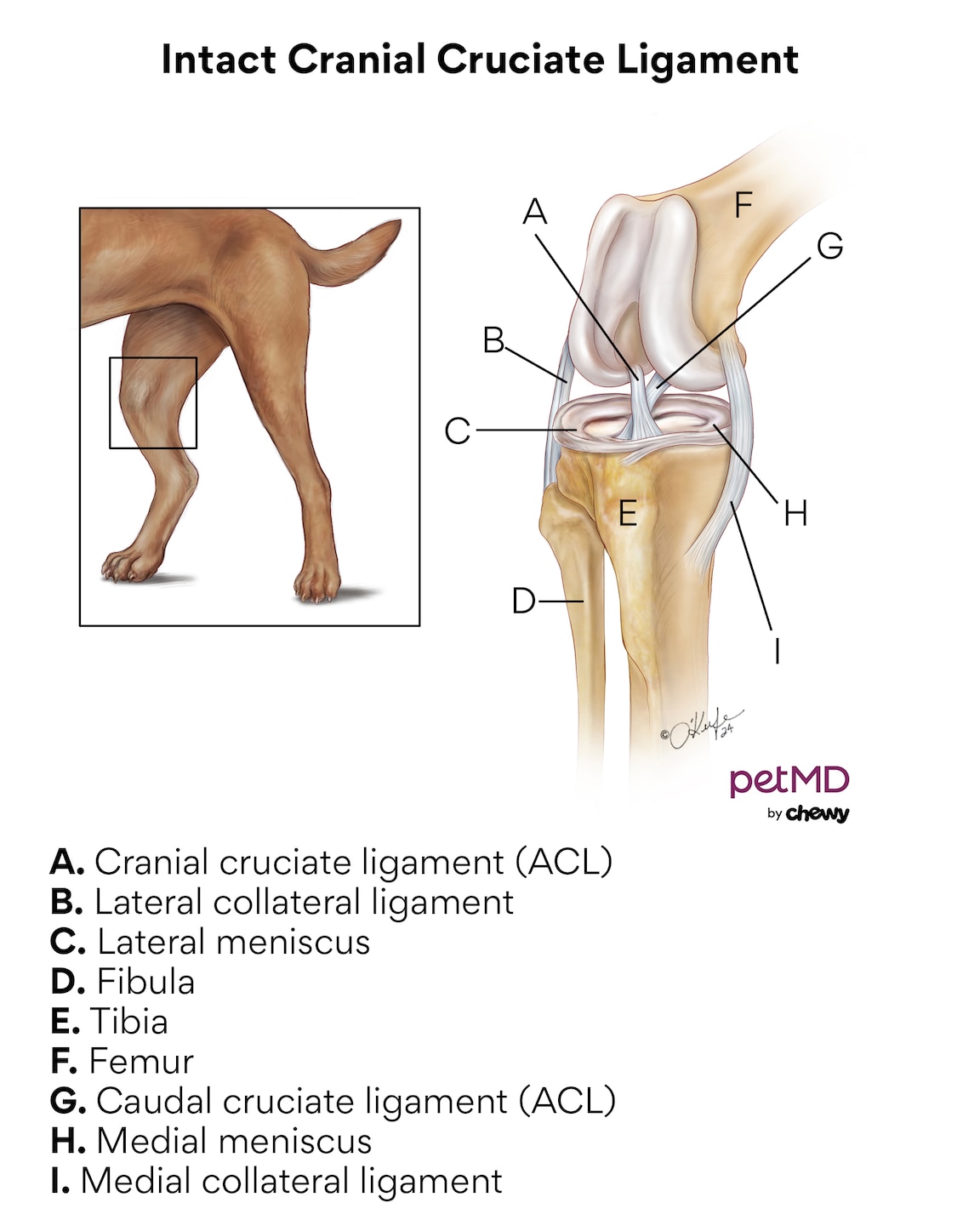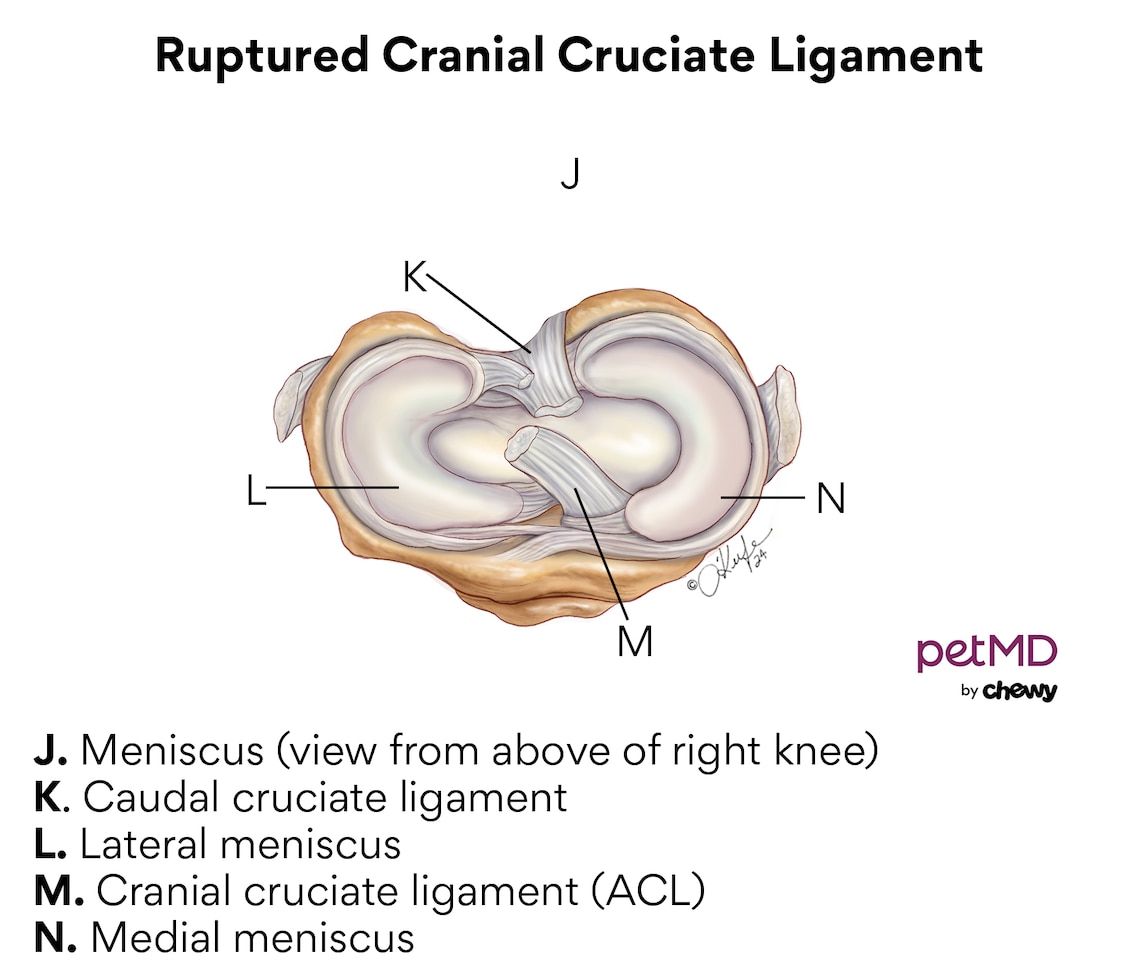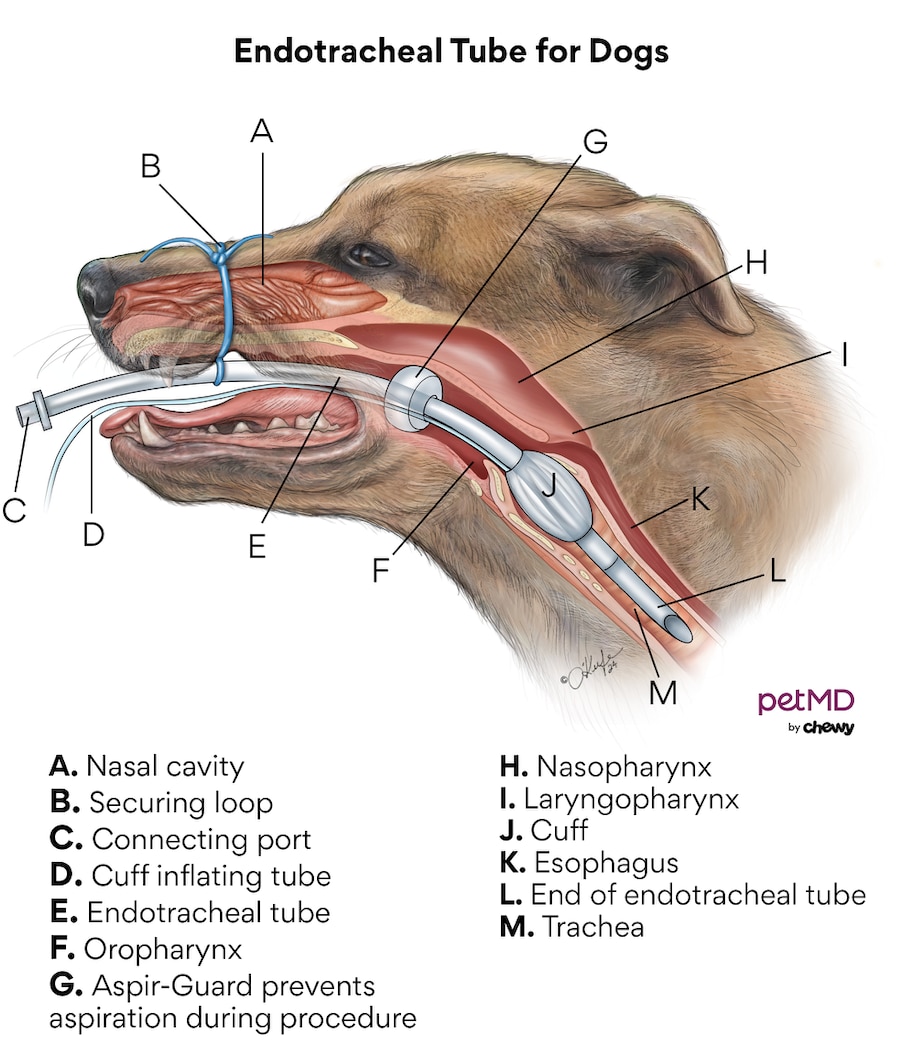ACL Surgery in Dogs
SeventyFour/iStock / Getty Images Plus via Getty Images
What Is ACL Surgery in Dogs?
The cranial cruciate ligament (CCL) plays an important role in normal knee function in dogs. It’s what a human would call their anterior cruciate ligament, or ACL.
When the CCL becomes damaged or torn in a dog, ACL surgery is required to repair it. The goal is to return a dog’s knee (stifle joint) back to a normal level of function and limit future instability and pain.
Unfortunately, the cruciate ligament doesn’t regenerate (regrow). Because of this, ACL surgery options in dogs either mimic the ligament or change the functionality of a dog’s joint.
Types of ACL Surgery in Dogs
Types of CCL surgery in dogs include:
-
Intracapsular—Suture material is placed within the joint, which mimics the cruciate ligament
-
Extracapsular—Suture material is placed outside the joint. A popular type is the Tightrope® technique, known for its ease. This involves tunneling through the leg bones and using a specially-designed suture anchored to the bones, which mimics the function of the CCL.
-
Osteotomy (bone cutting) procedures—The mechanics of the joint are changed; these procedures are more common.
-
Tibial plateau leveling osteotomy (TPLO)—The tibia is cut and rotated to prevent the femur from sliding backward, then held in place by metal plates and screws.
-
Tibial tuberosity advancement (TTA)—A portion of the tibia is cut, advanced forward, then anchored in place.
-
Anatomy of ACL in Dogs
The knee joint is a complex joint made up of six main ligaments:
-
Cranial and caudal cruciate ligaments—Located between the femur and tibia, they cross the joint and help to control forward and backward movement.
-
Medial and lateral collateral ligaments—These run on either side of the joint, help attach the femur to tibia, and help control sideways motion.
-
Meniscus—C-shaped discs that sit in between the femur and tibia bones, these ligaments provide absorption and load distribution of the dog’s weight and are often damaged when the cruciate ligament is torn.

Click here to download this medical illustration.

Click here to download this medical illustration.
Why Would a Dog Need ACL Surgery?
If your dog has been diagnosed with a cruciate ligament rupture or tear, the chance that he will need surgery is high if they are a large or giant breed, young, and active.
Without an intact cruciate ligament to stabilize a dog’s knee, instability occurs. This can lead to pain, inflammation, lameness, and arthritis.
Over time, stiffness to the limb develops, characterized by a loss of range of motion and difficulty getting up, climbing stairs, jumping up on the couch, decreased activity level, and muscle atrophy (loss of muscle).
Risks of ACL Surgery in Dogs
Though uncommon, ACL surgery in dogs has risks including:
-
Complications due to anesthesia, including death
-
Increased risk of joint infection (septic arthritis)
-
Failure of the bone to heal (nonunion) or heal abnormally (malunion)
-
Excessive bleeding
-
Failure of the plate and screws to remain in place
-
Breakage of the implant device
-
Infection of the implant
-
Post-operative complications, such as infection or inflammation at the incision site
Benefits of ACL Surgery in Dogs
Surgery of the cruciate ligament addresses the pain caused by instability and is the only way to fix the joint and ligaments themselves. Surgery offers a dog the best chance at returning the joint back to normal while minimizing pain and inflammation.
Before moving forward with ACL surgery in your dog, your vet will consider your dog’s size, weight, and activity level. Dogs of ideal body condition—such as ones that are younger and more active—are better candidates for surgery. Dogs that have partial CCL tears should undergo surgery because partial tears can develop into full tears, which will worsen pain and lameness.
ACL surgery in dogs can’t eliminate or prevent the development of arthritis.
Effectiveness of ACL Surgery in Dogs
This surgery has an estimated 85–90% success rate, though this varies depending on several factors. This includes the degree of inflammation and arthritis already present in a dog, the surgical technique used, and skill of the veterinary surgeon.
Cost of ACL Surgery in Dogs
The cost of ACL surgery in dogs varies, depending on location, type of surgery performed, and care facility. However, you may expect the cost to be anywhere from $1,500 to $7,000 or more.
Most pet insurance companies typically cover some or all the cost, unless specifically stated in their terms and conditions. Be sure to review your policy.
Other options may include applying for CareCredit or payment plans.
Preparation for ACL Surgery in Dogs
The day before ACL surgery for your dog, you may be asked not to feed him overnight, depending on when the surgery is scheduled. After the necessary paperwork is filled out, your dog will be hospitalized, have their blood drawn, and an IV catheter placed.
The vet will perform an exam, review the paperwork and blood work, and be given pre-medication—this includes pain medication and sedatives, which will facilitate anesthesia.
An endotracheal tube will be inserted so that your dog’s breathing can be monitored. Then, they will be prepared for surgery.

Click here to download this medical illustration.
Complications of ACL Surgery in Dogs
Most complications of ACL surgery in dogs are minor and can be treated without future surgeries, but major complications can occur such as:
-
Infection/inflammation at the incision site (most common)
-
Bone fracture
-
Implant failure, either of the plate itself, subsequent mobility, or failure to remain in place
-
Persistent lameness and failure to return to normal function
-
Opening of the incision and wound care and management issues
Post-op Care and Recovery for ACL Surgery in Dogs
Regardless of surgical technique, all dogs that undergo ACL surgery should have some degree of post-operative exercise restriction (usually two to three months) consisting of slow leash walks and crate rest, especially when unsupervised.
Some pups may benefit from calming medications or sedatives so they don’t cause further injury or failure of the surgery. Rehabilitation is slow and can take up to six months following surgery. However, most dogs will resume normal activity three to four months after surgery.
Future visits may include additional X-rays of the knee to make sure the bones are healing, and implants are working properly. Some exercises can be performed at home, such as passive range of motion exercises (gently flexing and extending the knee), but your vet may also recommend consultation with a rehabilitation veterinarian. Physical rehab can improve your dog’s recovery.
Other treatments include icing the joint several times a day and laser therapy to help decrease pain and swelling, increase mobility, and promote healing.
Pain medication and anti-inflammatory medications may be prescribed, such as:
Your vet may prescribe the following supplements to help reduce pain, minimize cartilage damage and swelling, increase joint lubrication, and help with cartilage production.
- Joint supplements, like Dasuquin™ or Cosequin™
- Glucosamine, chondroitin sulfate, omega-3 and omega-6 fatty acids, MSM
Overweight dogs have a more difficult time during recovery. If your dog is obese, there’s a risk of them reinjuring their joint or causing future injury to their other knee.
Your vet may recommend a weight loss diet, such as Hill’s® Meta-mobility, j/d, or Royal Canin® Advanced Mobility. Consult with your veterinarian on the best supplements and diet for your dog, based on their unique needs.
Failure to follow your veterinarian’s advice could result in further damage, additional complications, and necessitate more surgeries or treatments.
Alternatives of ACL Surgery in Dogs
Surgery may not be an option for all dogs due to their advanced age, significance of an underlying disease, inability to undergo anesthesia, or financial constraints of their pet parent.
These dogs can often be managed conservatively. This includes exercise restriction for several weeks, weight loss, and the prescription of pain medications or anti-inflammatories (NSAIDs).
This method doesn’t return the knee joint to normal function and doesn’t provide the necessary stabilization, but for smaller dogs—especially those that weigh less than 30 pounds—it does carry an estimated 85% success rate.
ACL Surgery in Dogs FAQs
What if I can’t afford ACL surgery for my dog?
Surgery is by far the best option for dogs suffering from cruciate rupture.
However, if surgery is not an option, then management consisting of cage rest, pain medications, anti-inflammatories (NSAIDs), and weight and exercise modification will most likely be recommended by your vet.
How long is dog ACL surgery?
The duration of surgery varies, based on the complexity of the disease or injury. However, ACL surgery in dogs typically takes two to four hours.
Featured Image: bluecinema/E+ via Getty Images
References
Casale S, McCarthy R. Complications associated with lateral fabellotibial suture surgery for cranial cruciate ligament injury in dogs: 363 cases (1997–2005). Journal of the American Veterinary Medical Association. 2009;234(2), 229-235.
Moore E, Weeren R, Paek M. Extended long-term radiographic and functional comparison of tibial plateau leveling osteotomy vs tibial tuberosity advancement for cranial cruciate ligament rupture in the dog. Veterinary Surgery. 2020; 49, 146-154.
Moore K, Read R. Cranial cruciate ligament rupture in the dog—a retrospective study comparing surgical techniques. Australian Australian Veterinary Journal. 1995; 72(8), 281-285.
Pacchiana P, et al. Surgical and postoperative complications associated with tibial plateau leveling osteotomy in dogs with cranial cruciate ligament rupture: 397 cases (1998–2001). Journal of the American Veterinary Medical Association 2003;222(2), 184-193.
Spinella G, Arcamone G, Valentini S. Cranial Cruciate Ligament Rupture in Dogs: Review on Biomechanics, Etiopathogenetic Factors and Rehabilitation. Veterinary Science. 2021; 8(9), 186.
Wolf R, at al. Surgical and postoperative complications associated with tibial tuberosity advancement for cranial cruciate ligament rupture in dogs: 458 cases (2007–2009). Journal of the American Veterinary Medical Association 2012;240(12), 1481-1487.
